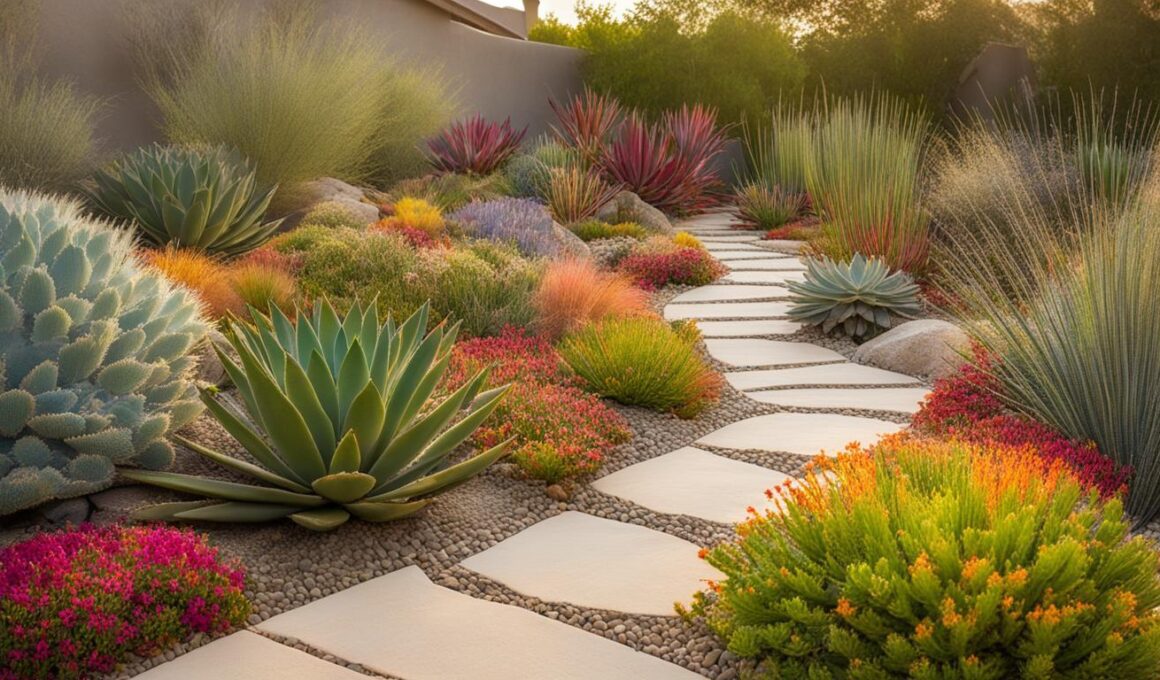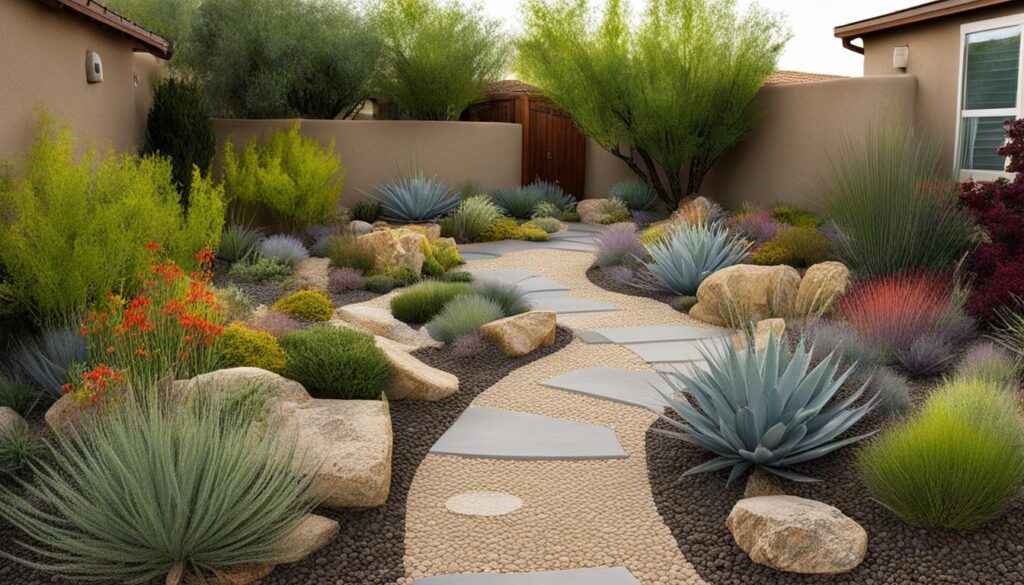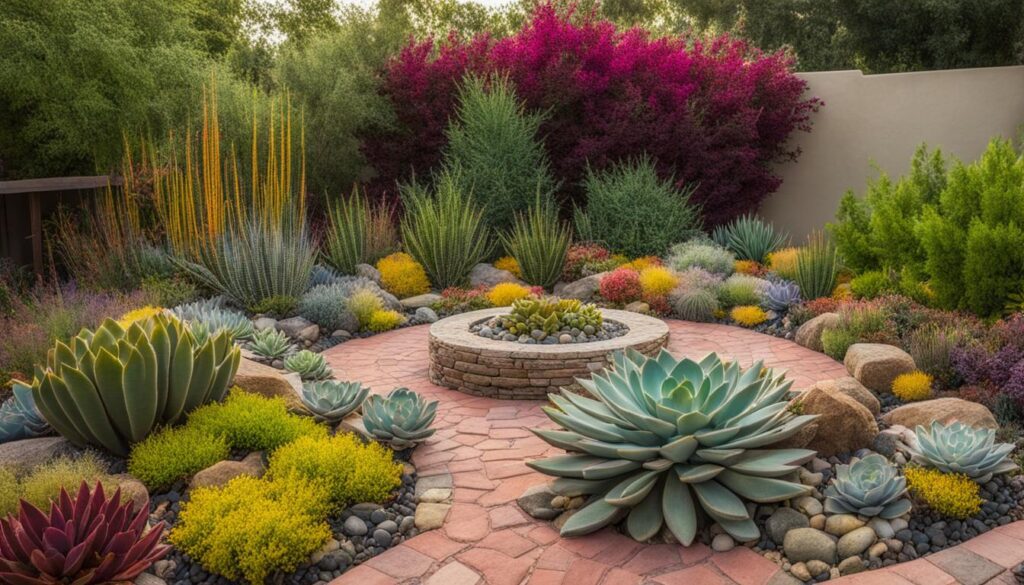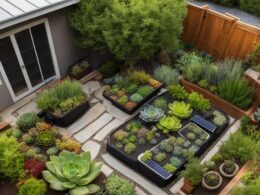Are you looking for cost-effective solutions to enhance your landscaping while conserving water? Look no further than xeriscaping – a sustainable and eco-friendly method that can transform your yard into a drought-tolerant paradise. By incorporating xeriscape principles such as efficient irrigation, soil improvements, and the use of drought-tolerant plants, you can achieve a beautiful and sustainable yard that not only saves water but also saves you money.
Key Takeaways:
- Xeriscaping is a cost-effective solution for landscaping that can help conserve water.
- By implementing efficient irrigation and using drought-tolerant plants, you can reduce your water usage while still maintaining a beautiful yard.
- Xeriscaping is especially beneficial in drought-prone areas, but it can be incorporated into any yard.
- Conserving water not only helps preserve natural ecosystems but also lowers energy demand and reduces utility bills.
- By following the principles of xeriscaping, you can create a sustainable and visually appealing landscape that benefits both the environment and your wallet.
Understanding Xeriscaping and Its Benefits
Xeriscaping, coined by Denver Water, is a landscaping method that uses as little water as possible to maintain a yard. It is popular in drought-prone areas but can be incorporated into any yard. Xeriscaping offers numerous benefits such as reducing water usage, lowering utility bills, conserving natural resources, and promoting biodiversity. By implementing efficient irrigation systems, using mulch, and selecting drought-tolerant plants, homeowners can enjoy a low-maintenance and eco-friendly yard that still looks beautiful.
Benefits of Xeriscaping
- Water Conservation: Xeriscaping significantly reduces water usage compared to traditional landscaping methods. By using drought-tolerant plants and efficient irrigation systems, homeowners can conserve water resources and contribute to sustainability.
- Low Maintenance: Xeriscaping requires less maintenance compared to traditional landscaping. With the right plant selection and mulching, homeowners can minimize the need for frequent watering, mowing, and pest control.
- Cost Savings: By reducing water consumption, xeriscaping can lead to significant savings on utility bills. Additionally, the use of native plants and mulch reduces the need for expensive fertilizers, pesticides, and other maintenance products.
- Biodiversity: Xeriscaping promotes biodiversity by using native and drought-tolerant plants. These plants provide habitats for local wildlife, including birds, bees, and butterflies, contributing to a healthier ecosystem.
Overall, xeriscaping offers a practical and sustainable solution for homeowners who want to create beautiful landscapes while conserving water and minimizing maintenance efforts. Whether you live in a drought-prone area or simply want to reduce your environmental footprint, xeriscaping can help you achieve your landscaping goals while benefiting the planet.
The 7 Principles of Xeriscaping
In order to create a sustainable yard that promotes water efficiency and reduces maintenance, it is important to follow the seven principles of xeriscaping:
- Planning and Design: Start by assessing your yard and creating a plan that takes into account the water and sunlight needs of different areas. This will help you determine the best placement for plants and maximize water efficiency.
- Soil Improvements: Prepare the soil by adding organic compost and other amendments to improve its structure and water-holding capacity. This will help plants thrive and reduce the need for excessive watering.
- Efficient Irrigation: Install an efficient irrigation system that delivers water precisely where and when it is needed. This can include drip irrigation, smart controllers, and rain sensors to optimize water usage.
- Plant Zones: Group plants with similar water and sunlight requirements together to ensure efficient watering. By creating distinct zones, you can avoid overwatering or underwatering certain plants.
- Mulches: Apply mulch around plants to conserve moisture, suppress weed growth, and regulate soil temperature. Organic mulches like wood chips or compost can also improve soil health over time.
- Turf Alternatives: Consider replacing traditional lawns with turf alternatives like native grasses, groundcovers, or hardscape features. These alternatives require less water and maintenance while still providing aesthetic appeal.
- Maintenance: Regular maintenance is key to keeping your xeriscape yard healthy and thriving. This includes proper pruning, removing weeds, monitoring irrigation systems, and replenishing mulch as needed.
By following these principles, homeowners can create a sustainable and water-efficient yard that not only saves resources but also reduces maintenance requirements. Incorporating xeriscape principles into your landscaping can significantly contribute to water conservation efforts and create a beautiful outdoor space for you to enjoy.
Who Benefits From Xeriscaping?
Xeriscaping is a landscaping method that offers a wide range of benefits, making it advantageous for various individuals and communities. Here are some groups of people who can benefit from implementing xeriscaping techniques:
1. Residents in Drought-Prone Areas:
If you live in areas regularly affected by droughts, such as California, Arizona, Nevada, and Colorado, xeriscaping is particularly beneficial. By reducing water usage through xeriscaping, you can still maintain a beautiful yard while conserving water, even during drought seasons.
2. Homeowners Looking to Save on Water Bills:
Xeriscaping can lead to significant water bill savings over time. By minimizing water usage and implementing efficient irrigation systems, homeowners can reduce their water consumption and lower their utility bills, putting more money back in their pockets.
3. Individuals Committed to Water Conservation:
Xeriscaping is an excellent practice for anyone who recognizes the importance of conserving water. Regardless of your location, water is a valuable resource that should be conserved to ensure its availability for future generations. Implementing xeriscaping techniques allows you to play a part in preserving natural ecosystems and reducing the strain on water resources.
4. Eco-Conscious Individuals:
If you have a passion for environmental sustainability, xeriscaping aligns perfectly with your values. By reducing water usage, xeriscaping helps to lower energy demand associated with water treatment plants and minimizes the need for chemical fertilizers and pesticides. This eco-friendly approach promotes biodiversity and contributes to a healthier environment.
Overall, xeriscaping offers numerous benefits that extend beyond individual homeowners. It can help conserve water, save money on utility bills, and contribute to a sustainable future for our planet.
The Cost of Xeriscaping
Xeriscaping, while offering numerous benefits, also comes with a cost. The cost of xeriscaping depends on various factors such as the size of your yard, the type of plants and materials used, and whether you choose professional installation or opt for a DIY approach.
On average, professional xeriscape landscaping can cost between $5 to $20 per square foot. For example, a 1,200-square-foot yard could cost around $17,000, while a 500-square-foot yard may cost around $6,000. However, keep in mind that these are just average estimates, and prices can vary depending on your specific location and project requirements.
But don’t worry if you’re on a budget! There are ways to make xeriscaping more affordable. For instance, you can save money by doing the physical labor yourself instead of hiring professionals. Additionally, consider using seeds and plant cuttings instead of buying fully grown plants, as they tend to be more cost-effective. You can also utilize budget-friendly elements like shells and pebbles in your landscaping design.
Moreover, some states offer turf replacement rebates as an incentive to homeowners to replace their lawns with xeriscape landscaping. These rebates can further reduce the overall cost of your xeriscaping project, making it a more budget-friendly option.
Key Takeaways:
- The cost of xeriscaping depends on factors like yard size, plant and material choices, and professional installation.
- Professional xeriscape landscaping can range from $5 to $20 per square foot.
- DIY xeriscaping can save money by doing the physical labor yourself and using cost-effective elements like seeds and plant cuttings.
- Some states offer turf replacement rebates to further reduce the cost of xeriscaping.
Budget-Friendly Xeriscaping: Creating a Beautiful Yard on a Shoestring
Xeriscaping your yard doesn’t have to break the bank. With some creativity and strategic planning, you can achieve a cost-effective and eco-friendly landscape that will make your neighbors green with envy. Here are some budget-friendly tips to help you transform your yard into a xeriscape oasis.
1. DIY Landscaping:
Save money on labor costs by taking a hands-on approach to your xeriscape project. Digging, planting, and installing irrigation systems yourself can be a rewarding experience and a significant money-saver. Enlist the help of family and friends, and turn your xeriscape project into a fun and collaborative effort.
2. Embrace Cost-Effective Materials:
When it comes to xeriscaping, there is a wide range of cost-effective materials to choose from. Instead of expensive decorative stones, consider using shells or pebbles as mulch. These alternatives can add visual interest to your yard while keeping costs low. Additionally, utilize recycled materials, such as reclaimed wood or old bricks, for borders and pathways.
“Transform your yard into an eco-friendly haven without breaking the bank.”
3. Take Advantage of Turf Replacement Rebates:
Many states offer turf replacement rebates to incentivize homeowners to replace their lawns with water-conserving landscapes. These rebates can significantly offset the cost of xeriscaping materials and installation. Check with your local water utility or government agencies to see if you qualify for any rebates or financial incentives.
By following these budget-friendly strategies and getting creative with your xeriscape design, you can achieve a stunning and water-efficient yard without breaking the bank.
Step-by-Step Guide to Xeriscaping Your Yard
Transforming your yard into a xeriscape masterpiece is a straightforward process that can significantly reduce water usage while creating a visually appealing landscape. By following these step-by-step guidelines, you’ll be well on your way to achieving a sustainable and cost-effective yard.
1. Planning and Design
Begin by mapping out your yard and identifying different zones based on sunlight and water needs. This will help you determine the best placement for various plants and irrigation systems. Consider factors such as the slope of your yard, existing structures, and the overall aesthetic you want to achieve.
2. Soil Preparation
Preparing the soil is key to a successful xeriscape. Start by regrading your yard to ensure proper drainage, as excessive water can be detrimental to drought-tolerant plants. Test the pH levels of your soil and make any necessary adjustments. Incorporate organic compost and mulch to improve soil quality and moisture retention.
3. Mulching and Irrigation
Apply a layer of mulch around your plants to reduce evaporation, suppress weed growth, and regulate soil temperature. Choose organic mulch materials such as wood chips or straw for optimum results. Install efficient irrigation systems, such as drip irrigation or soaker hoses, to deliver water directly to the roots of your plants.
4. Plant Selection
Choose plants that are well-suited to your climate and soil conditions. Opt for drought-tolerant varieties that require minimal watering once established. Native plants are an excellent choice as they are adapted to the local environment and often require less maintenance. Consider creating plant groupings based on water needs to streamline irrigation.
5. Maintenance
Regular maintenance is essential to keep your xeriscape yard in top shape. Weed diligently to prevent competition for water and nutrients. Check and adjust irrigation systems regularly to ensure efficient water distribution. Prune and remove dead or damaged plant material as needed. With proper maintenance, your xeriscape yard will continue to thrive and provide long-term benefits.
How Can I Implement Cost-Effective Xeriscape Solutions for a Large Property?
Implementing cost-effective xeriscape landscape design ideas for a large property can be achieved through thoughtful planning and creative use of native plants, efficient irrigation systems, and strategic placement of hardscaping elements. Incorporating low-maintenance features and utilizing natural elements can help minimize water usage and maintenance expenses.
:How Can Organic Soil Amendments Help in Creating Cost-Effective Xeriscape Landscaping Solutions?
Organic soil amendments for xeriscape can be a game-changer when it comes to creating cost-effective landscaping solutions. These amendments help improve soil structure and water retention, reducing the need for irrigation. By using organic soil amendments, xeriscaping becomes more sustainable and affordable while promoting healthy plant growth.
Conclusion
Xeriscaping offers numerous benefits for homeowners who are looking to conserve water and create eco-friendly landscapes. By implementing the principles of xeriscaping, you can enjoy a visually appealing and low-maintenance yard while saving on water usage and utility bills. This cost-effective solution is especially beneficial in drought-prone areas, but can be incorporated into any yard to promote water conservation.
With xeriscaping, you have the opportunity to create an environmentally sustainable landscape that minimizes water waste and preserves natural resources. By following the step-by-step guide, you can easily transform your yard into a beautiful and functional space that benefits both the environment and your wallet.
By choosing water-wise plants, implementing efficient irrigation systems, using mulch to reduce evaporation, and practicing regular maintenance, you can create an eco-friendly landscape that requires less water and upkeep. Xeriscaping is a cost-effective solution that allows you to have a thriving yard while minimizing the impact on the environment.
Make the choice to embrace xeriscaping and contribute to water conservation efforts while creating a beautiful, low-maintenance landscape. With its many benefits, xeriscaping is the ideal solution for homeowners seeking a cost-effective and eco-friendly landscaping option.














